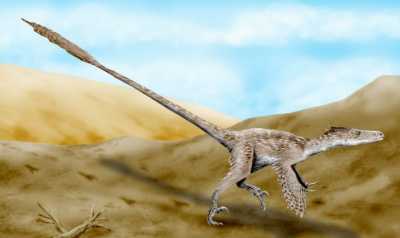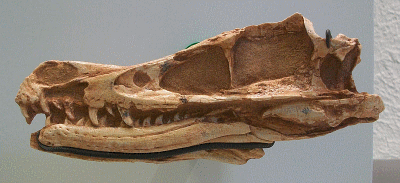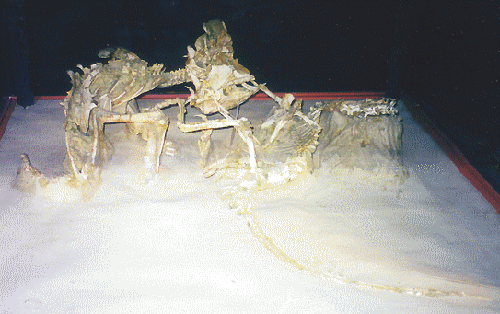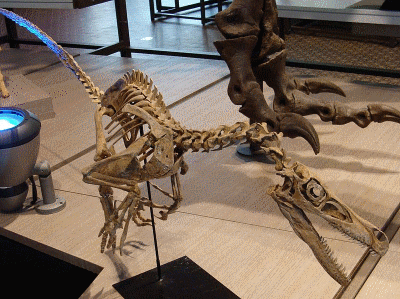 Velociraptor VelociraptorFamiliar
to many fans of Jurassic Park, the
real-life Velociraptor actually had little in
common with its movie counterpart.
The Velociraptor that lived in
what is now Mongolia and northern China during
the Late Cretaceous Period (about 70-65 million
years ago) had
an s-shaped neck, arms with three-fingered clawed
hands, long thin legs, and four-toed clawed feet.
It was about 6 feet long,
stood up to 3 feet tall, and weighed up to 40
pounds.  The skull, which grew up to 10 inches
long, was uniquely up-curved, concave on the
upper surface and convex on the lower. The jaws
were lined with 26-28 serrated, widely-spaced
teeth up to an inch or more long on each side.
Its most prominent feature was a long tail, which
likely kept it balanced as it ran and allowed it
to make quick turns. Paleontologists estimate
that the Velociraptor could run up to 40 miles
per hour for short bursts and jump as high as 10
feet straight up into the air. The skull, which grew up to 10 inches
long, was uniquely up-curved, concave on the
upper surface and convex on the lower. The jaws
were lined with 26-28 serrated, widely-spaced
teeth up to an inch or more long on each side.
Its most prominent feature was a long tail, which
likely kept it balanced as it ran and allowed it
to make quick turns. Paleontologists estimate
that the Velociraptor could run up to 40 miles
per hour for short bursts and jump as high as 10
feet straight up into the air.
A few fossils have provided
evidence that the Velociraptor had feathers, but
its anatomy did not allow it to fly. It is likely
that the feathers helped the Velociraptor attract
mates, regulate its body temperature, and helped
females protect their eggs. Since no Velociraptor
fossil has ever been found with either feathers
or skin, it is left to individual artists to
determine what it looked like.
 Although the Velociraptors in Jurassic
Park hunted in packs, every fossil found to
date has been of a solitary individual, leading
paleontologists to assume that it hunted alone.
Paleontologists have also concluded that
Velociraptor preyed on other dinosaurs, a
conclusion that was made possible by the
discovery of the fossilized remains of a
Velociraptor locked in combat with a comparably
sized Protoceratops. The Velociraptor was
attacking the Protoceratops with its
2.5-inch-long claws while the Protoceratops was
biting down on the Velociraptor's head when the
two were apparently buried in a sudden sand
avalanche. Although the Velociraptors in Jurassic
Park hunted in packs, every fossil found to
date has been of a solitary individual, leading
paleontologists to assume that it hunted alone.
Paleontologists have also concluded that
Velociraptor preyed on other dinosaurs, a
conclusion that was made possible by the
discovery of the fossilized remains of a
Velociraptor locked in combat with a comparably
sized Protoceratops. The Velociraptor was
attacking the Protoceratops with its
2.5-inch-long claws while the Protoceratops was
biting down on the Velociraptor's head when the
two were apparently buried in a sudden sand
avalanche.
 The first
Velociraptor fossil was discovered in the Gobi
Desert of Mongolia in 1923 by Peter Kaisen,
during an expedition sponsored by the American
Museum of Natural History in New York. Museum
president Henry F. Osborn gave this raptor its
name, which means "speecy thief" in
Greek, in 1924. About a dozen specimens have been
found to date, all but one of them in Mongolia;
the one exception was discovered in northern
China. All of the fossil recovery sites bear
evidence of an arid environment with fields of
sand dunes and only intermittent streams. The first
Velociraptor fossil was discovered in the Gobi
Desert of Mongolia in 1923 by Peter Kaisen,
during an expedition sponsored by the American
Museum of Natural History in New York. Museum
president Henry F. Osborn gave this raptor its
name, which means "speecy thief" in
Greek, in 1924. About a dozen specimens have been
found to date, all but one of them in Mongolia;
the one exception was discovered in northern
China. All of the fossil recovery sites bear
evidence of an arid environment with fields of
sand dunes and only intermittent streams.
Scientific
Classification
phylum Chordata
subphylum Vertebrata
class Archosauria
order Saurischia
family Dromaeosauridae
genus & species Velociraptor mangoliensis
Questions or comments about
this page?
|



